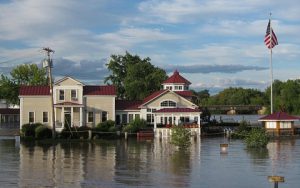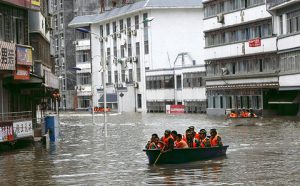The Asia-Pacific region is one of the most vulnerable in the world to flooding and other water-related natural catastrophes. In the past 30 years alone 1.7 billion people here have been affected by flooding events resulting in economic losses of almost US$222 billion. By 2050, over 40 cities in the region with populations over 5 million, including Dhaka, Kolkata, Shanghai, Mumbai, Jakarta, Bangkok and Ho Chi Minh City, will be highly vulnerable to flooding – exposing trillions of dollars worth of assets and infrastructure to flood damage.
Traditionally, cities have invested in “grey” infrastructural solutions such as dams and levees to mitigate risks from flooding. However, grey infrastructure is capital intensive to build, operate, maintain and replace; and since it is built to address a specific water-management problem in once place, can amplify risks downstream. It also often degrades the quality and quantity of water available for ecosystems, leading to environmental degradation.
In contrast, green infrastructure uses natural or semi-natural systems to manage water resources and associated risks. In cities, this means using vegetation and forests, green spaces, green roofs and permeable pavements to protect inhabitants and buildings from floods. Green infrastructure has other benefits too: green urban spaces support wildlife and provide recreational space for local neighbourhoods.
Unlike grey infrastructure, they also appreciate in value over time by regenerating nature and its associated ecosystem services such as water purification.
Cities learn to prioritise
In Europe, the European Commission promotes green infrastructure solutions as an alternative way to manage floods. Cities including Copenhagen, Hamburg and Rotterdam have embraced this approach, and offer many lessons to cities in Asia.
Copenhagen has developed a Cloudburst Management Plan, which guides strategies to counter extreme rainfall and associated economic loss over 20 years. Without adequate adaptation measures, extreme rainfall is expected to cause over 2-billion euros worth of damage to the city over the next 100 years. The costs associated with adaptation outlined in the new plan, however, are less: between 800,000 and 1.1 billion euros, funded by a mix of public (tax and city-owned utility charges) and private investment. Initiatives proposed include channelling stormwater away from housing and infrastructure through tunnels and canals into lakes or out to sea, and using green spaces and car parks as temporary floodwater-storage areas.
However, as Copenhagen lacks the financial resources and capacity to implement citywide adaptation measures all at once, the Cloudburst Plan provides guidance on how to prioritise projects. This is done by identifying parts of the city at highest risk of flooding in monetary terms; areas where measures can be easily implemented with no adverse impacts on surrounding regions; areas where projects can be implemented in conjunction with renovation projects and new urban developments; and areas where synergies can be gained – for instance using green spaces to reduce the volume of water entering wastewater-treatment plants.
In Hamburg the Ministry of Urban Development and Environment has partnered with the public water utility, Hamburg Wasser, to launch the Rain InfraStructure Adaptation (RISA) scheme to provide flood protection and promote water conservation. With a budget of 1.75 million euros, the project will draw on a wide range of expertise, from traffic planners to civil engineers, to develop an integrated stormwater management plan for the city.
In 2013, RISA commissioned several pilot projects, including Germany’s first “rain playground”. The scheme provides a space for young children to play with water and protects the area from flooding by channelling surface runoff to recharge groundwater supplies. In the future, the integrated stormwater management plan will provide guidance on constructing buildings that channel excess water into storage ponds, car parks that collect, purify and then discharge rainwater and green spaces such as sports fields to store stormwater.
Rotterdam is investing 100 million euros of public and private funding to climate proof itself from future storm events, including upgrading stormwater systems.
This involves building underground water-storage spaces that can also be used as car parks and using water squares in public areas to temporarily store stormwater. Individuals are also encouraged to get involved by replacing paving in their own gardens with plants and vegetation.
The European experience provides five main lessons for Asian cities. First, identify the highest priority areas that require green infrastructure solutions to ensure financial sustainability. Second, seek connections between green infrastructure projects to maximise economic and environmental benefits. Third, integrate green solutions into urban and regional plans. Four, create ownership of green infrastructure solutions by involving local citizens and experts. And five, provide an enabling environment for companies to test green infrastructure technologies that will create green jobs.







